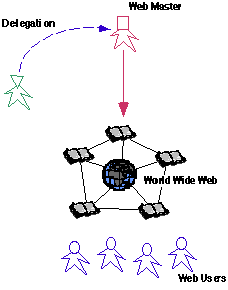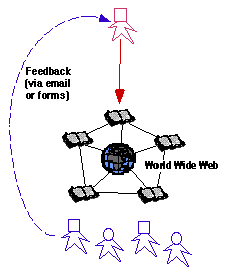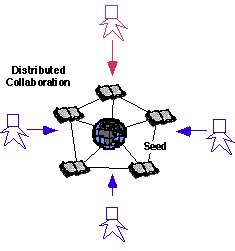
|
M1 - The Web as a Broadcast Medium
This is currently the prevalent model on the Web. Because so much extra knowledge is required to make web pages and place them on a server, most people must delegate this task to a "webmaster." This is bad because the webmaster generally doesn't understand the content. And also, people should be able to express themselves directly if they desire (particularily in the case of design). Lastly, web users should not be limited to passive consumers of information - they should be able to be producers as well.
|

|
M2 - Indirect Collaboration
There is a growing trend toward placing email tags or forms in web pages to permit from users. The problem with these techniques is that the feedback must go through someone before it appears on a webpage. Mediated discussions have their place, but my claim is that, for collaborative design, such mediation is not desirable. This is because design is a process of struggling with a problem to gain a shared understanding, and a "middle-man" (i.e., a webmaster) gets in the way of this process by coming between the problem and the designers who are trying to understand it.
|

|
M3 - Direct Modification
The M3 model of direct collaboration is the desired situation for collaborative design. In this model, users may directly modify the contents of information and communicate with each other, mediated only by the dynasites technology and the ideas expressed within it.
Dynasites supports direct modification by storing information in a database, and creates web pages "on the fly". When users provide feedback (via forms), this feedback is placed into the database, and the next time the page is viewed, the new database contents are displayed. Dynasites is not the ultimate in direct modification (java allows direct manipulation as well as direct modification), but it is a step in the right direction, because it allows users to have equal and direct contact with the information space without requiring a human intermediary.
|



